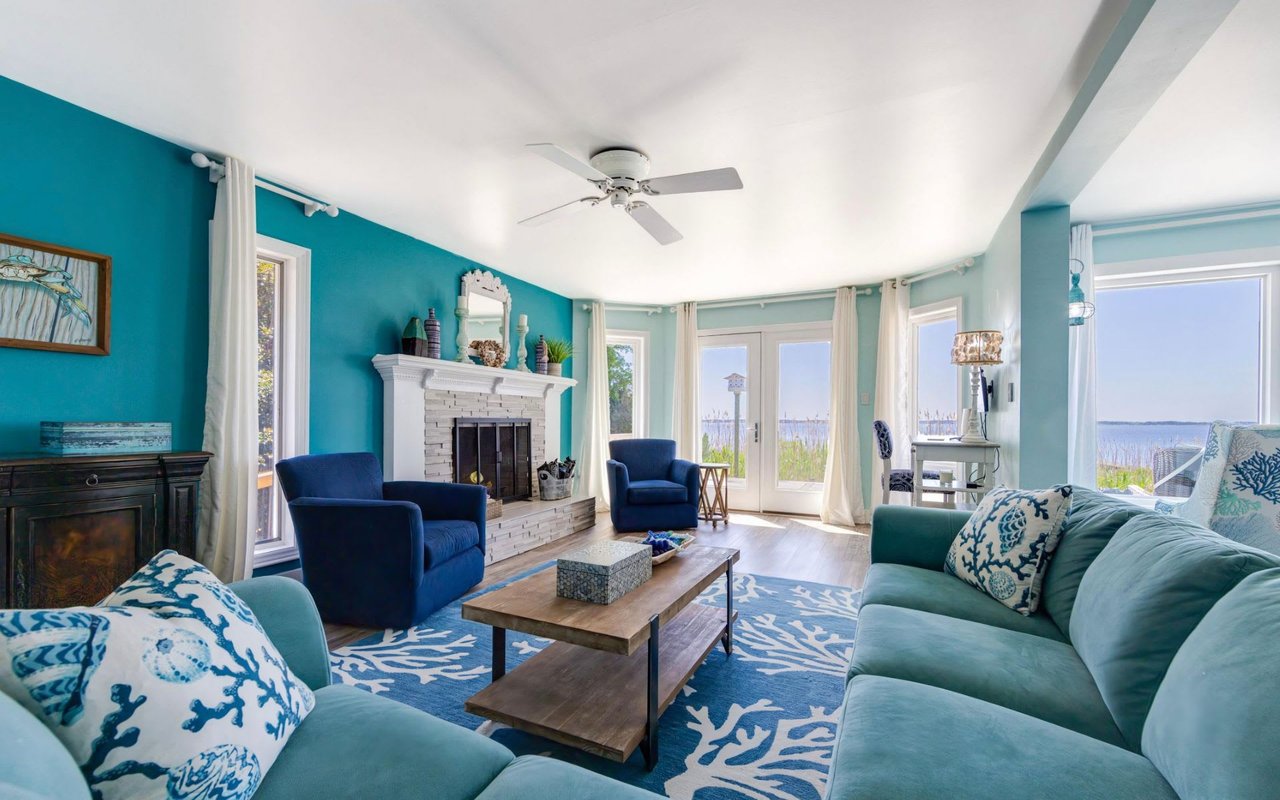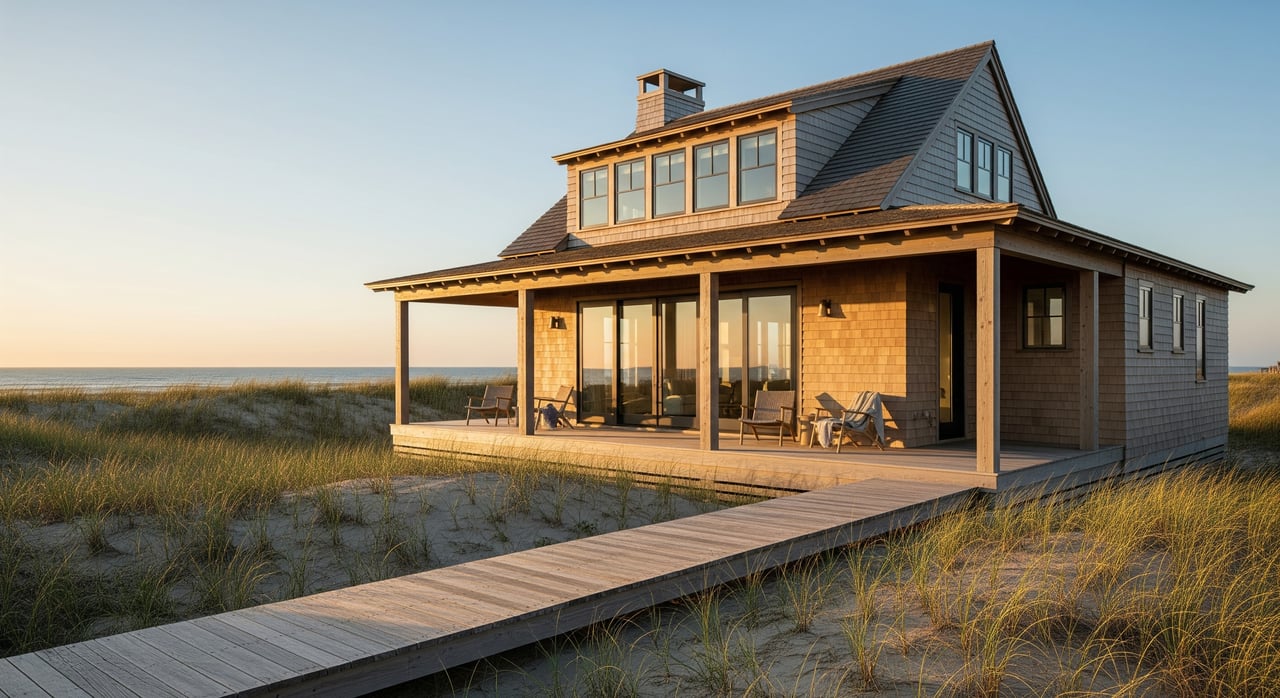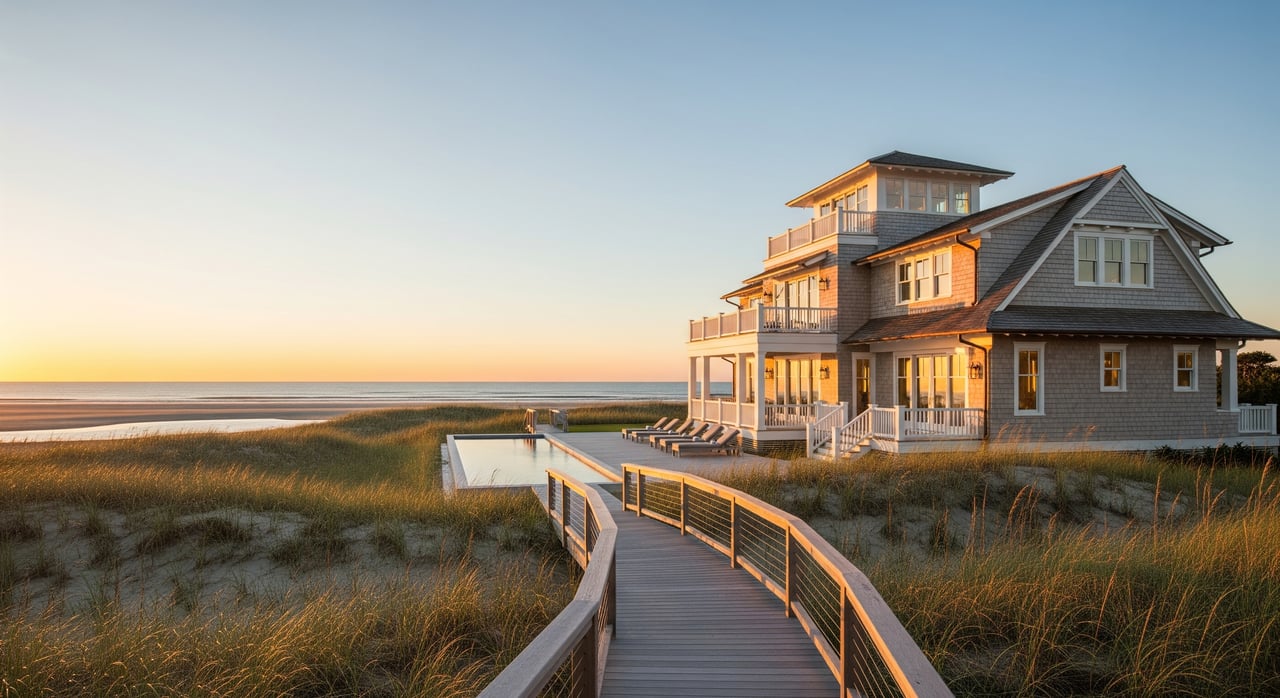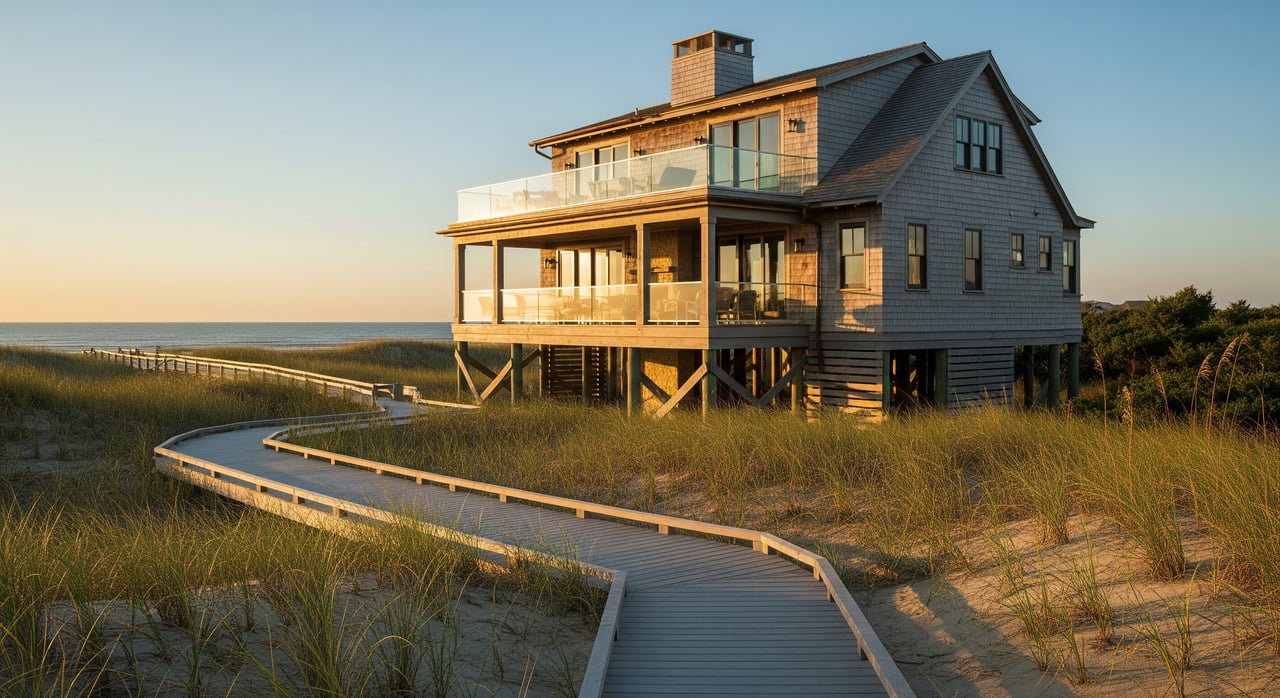Decorating a historic home in the Outer Banks is a unique blend of preserving local coastal heritage and creating a comfortable, modern living environment. Known for its maritime history, these homes are often rich in architectural details that reflect the area's connection to the sea, making them special pieces of North Carolina's coastal culture. Whether you own a charming beach cottage or a stately historic house, decorating in a way that honors the Outer Banks’ storied past while bringing in modern conveniences requires careful planning and thoughtful design.
Understanding the Coastal History of the Outer Banks
Before diving into your decorating journey, it’s important to take a moment to understand the history of your Outer Banks home. This coastal area, with its roots in fishing, shipbuilding, and trade, has a distinct architectural style shaped by the sea. Many historic homes in the area were built to weather storms and salt air, often featuring materials like cedar shakes, wooden beams, and large windows to capture sea breezes.
Studying the historical and architectural features of your home will provide invaluable insight as you make design choices. Whether your home reflects the simplicity of early coastal cottages or the grandeur of later plantation-style estates, paying tribute to its origins will enhance its charm. Seeking out local history through museums, archives, or conversations with long-time residents can also deepen your understanding of the period in which your home was built.
Studying the historical and architectural features of your home will provide invaluable insight as you make design choices. Whether your home reflects the simplicity of early coastal cottages or the grandeur of later plantation-style estates, paying tribute to its origins will enhance its charm. Seeking out local history through museums, archives, or conversations with long-time residents can also deepen your understanding of the period in which your home was built.
Preserving the Character of Coastal Architecture
The allure of historic homes in the Outer Banks often lies in their connection to the natural environment and their ability to blend with the coastal landscape. To maintain this connection, it’s essential to preserve the character of the architecture when decorating. If your home boasts original cedar shake siding, wide plank floors, or exposed beams, you should focus on restoring and highlighting these features rather than covering them up.
Use decor that aligns with the coastal charm of the Outer Banks. For instance, maritime-themed elements like rope accents, nautical light fixtures, and weathered wood pieces can complement the home's history without overwhelming the design. These details add authenticity while maintaining a connection to the sea, which has shaped so much of the area’s history.
Use decor that aligns with the coastal charm of the Outer Banks. For instance, maritime-themed elements like rope accents, nautical light fixtures, and weathered wood pieces can complement the home's history without overwhelming the design. These details add authenticity while maintaining a connection to the sea, which has shaped so much of the area’s history.
Integrating Modern Comfort with Outer Banks Tradition
While preserving history is important, living in a historic home should also be comfortable and functional for modern life. Homes built in the Outer Banks, especially those dating back over a century, were designed for a simpler time. Rooms may be smaller, and the layout might feel less open compared to modern homes. It’s important to carefully integrate modern conveniences without detracting from the home’s original character.
For example, kitchens in older Outer Banks homes may have been designed for smaller-scale cooking and storage. Updating these spaces with modern appliances is essential, but you can do so while maintaining a vintage aesthetic. Consider custom cabinetry that mimics the original design, or use reclaimed wood to create a seamless transition between the old and new. When upgrading bathrooms, you might install modern fixtures while retaining period-appropriate tiles or clawfoot tubs to blend contemporary function with historic charm.
For example, kitchens in older Outer Banks homes may have been designed for smaller-scale cooking and storage. Updating these spaces with modern appliances is essential, but you can do so while maintaining a vintage aesthetic. Consider custom cabinetry that mimics the original design, or use reclaimed wood to create a seamless transition between the old and new. When upgrading bathrooms, you might install modern fixtures while retaining period-appropriate tiles or clawfoot tubs to blend contemporary function with historic charm.
Coastal-Inspired Color Palettes
Decorating a historic Outer Banks home gives you the opportunity to draw inspiration from the natural beauty of the surrounding coastal landscape. Historically, homes in this region embraced colors that reflected the environment. Soft blues, sandy beiges, weathered whites, and seafoam greens echo the ocean, sky, and dunes, creating a calming, cohesive atmosphere.
When choosing a color palette, consider incorporating these natural, muted tones to connect your home to its coastal surroundings. Many historic homes in the Outer Banks also feature deep, rich wood tones that have aged beautifully over time. These natural materials can be complemented by lighter wall colors, allowing the woodwork to stand out as a focal point.
If you want to stay true to the historic aesthetic, research the traditional colors used during your home’s era. Many paint companies offer collections based on historical periods, which can guide you toward authentic choices. However, don’t feel confined to these palettes—contemporary neutrals or even soft, coastal-inspired pastels can breathe new life into the space while maintaining the home’s integrity.
When choosing a color palette, consider incorporating these natural, muted tones to connect your home to its coastal surroundings. Many historic homes in the Outer Banks also feature deep, rich wood tones that have aged beautifully over time. These natural materials can be complemented by lighter wall colors, allowing the woodwork to stand out as a focal point.
If you want to stay true to the historic aesthetic, research the traditional colors used during your home’s era. Many paint companies offer collections based on historical periods, which can guide you toward authentic choices. However, don’t feel confined to these palettes—contemporary neutrals or even soft, coastal-inspired pastels can breathe new life into the space while maintaining the home’s integrity.
Highlighting Architectural Features Unique to the Outer Banks
Historic homes in the Outer Banks often feature architectural details unique to the region. Large porches for enjoying the ocean breeze, wide plank floors made from local wood, and charming dormer windows are just a few of the standout elements that should be preserved and celebrated. These features not only define the home’s personality but also reflect the craftsmanship of a bygone era.
When decorating, make these architectural details the star. For example, if your home has a wide front porch typical of Outer Banks cottages, furnish it with period-appropriate outdoor furniture like wicker chairs or Adirondack loungers. If you have beautiful woodwork inside, such as exposed beams or tongue-and-groove ceilings, keep the decor minimal to let these features shine. The simplicity and function of coastal architecture are meant to be appreciated, not hidden.
When decorating, make these architectural details the star. For example, if your home has a wide front porch typical of Outer Banks cottages, furnish it with period-appropriate outdoor furniture like wicker chairs or Adirondack loungers. If you have beautiful woodwork inside, such as exposed beams or tongue-and-groove ceilings, keep the decor minimal to let these features shine. The simplicity and function of coastal architecture are meant to be appreciated, not hidden.
Mixing Textures and Fabrics for a Coastal Look
When decorating any historic home, texture is key to creating a warm, inviting environment. In the Outer Banks, it’s easy to take cues from the surrounding natural environment when choosing materials. Incorporate natural fibers like linen, cotton, and jute, which evoke the coastal atmosphere and lend a relaxed, casual feel to the space.
For example, lightweight linen curtains that sway in the breeze, jute rugs that mimic the texture of sand, and slipcovered furniture in soft, weathered hues can enhance the coastal character of the home. Layering different textures not only makes the space more comfortable but also adds depth, especially when contrasted with harder architectural elements like wood beams or stone fireplaces.
For example, lightweight linen curtains that sway in the breeze, jute rugs that mimic the texture of sand, and slipcovered furniture in soft, weathered hues can enhance the coastal character of the home. Layering different textures not only makes the space more comfortable but also adds depth, especially when contrasted with harder architectural elements like wood beams or stone fireplaces.
Lighting for Historic Coastal Homes
Lighting plays a crucial role in creating the right ambiance for your Outer Banks home. Historically, homes in this area were built with large windows to let in as much natural light as possible, taking advantage of the region's bright, sunny days. It’s important to preserve this connection to the outdoors by keeping window treatments light and airy.
To complement natural light, incorporate fixtures that reflect the coastal and historical character of your home. Lantern-style pendant lights, nautical sconces, and vintage-inspired chandeliers can all enhance the period aesthetic while adding a touch of elegance. If your home has original light fixtures, restoring them can preserve a sense of authenticity, but be sure to add modern lighting elements where needed for practicality.
To complement natural light, incorporate fixtures that reflect the coastal and historical character of your home. Lantern-style pendant lights, nautical sconces, and vintage-inspired chandeliers can all enhance the period aesthetic while adding a touch of elegance. If your home has original light fixtures, restoring them can preserve a sense of authenticity, but be sure to add modern lighting elements where needed for practicality.
Artwork and Accessories: Coastal Heritage with Modern Flair
The finishing touches in any historic home come from artwork and accessories, and in the Outer Banks, you have a wealth of local history to draw from. Nautical maps, vintage seascapes, and coastal photography can all bring a sense of place into your home. Consider displaying local artwork that celebrates the area’s maritime heritage or photographs that capture the beauty of the Outer Banks' beaches, lighthouses, and dunes. Don’t be afraid to mix modern pieces with traditional coastal decor. A contemporary painting of the ocean can hang alongside a vintage wooden chest or antique nautical items. By blending old and new, you create a layered look that feels both current and respectful of the home’s past.
Crafting a Timeless Coastal Retreat
Decorating a historic home in the Outer Banks is an opportunity to honor both the architectural integrity of the space and the unique coastal culture of North Carolina. By preserving original features, embracing the natural landscape, and thoughtfully integrating modern updates, you can create a home that is both a reflection of the past and a comfortable space for today’s lifestyle.
The charm of the Outer Banks lies not only in its natural beauty but also in the stories embedded within its historic homes. By carefully balancing history with modern design, you can ensure that your home tells a story of coastal heritage while serving as a serene and stylish retreat for years to come.
When attempting to traverse a niche market like the Outer Banks, you’re best suited when paired with an experienced agent. Brad Beacham has been a trusted name in this market for years, matching client after client with their dream homes in and around the Outer Banks. Consider him when beginning your journey to your next home.
The charm of the Outer Banks lies not only in its natural beauty but also in the stories embedded within its historic homes. By carefully balancing history with modern design, you can ensure that your home tells a story of coastal heritage while serving as a serene and stylish retreat for years to come.
When attempting to traverse a niche market like the Outer Banks, you’re best suited when paired with an experienced agent. Brad Beacham has been a trusted name in this market for years, matching client after client with their dream homes in and around the Outer Banks. Consider him when beginning your journey to your next home.




